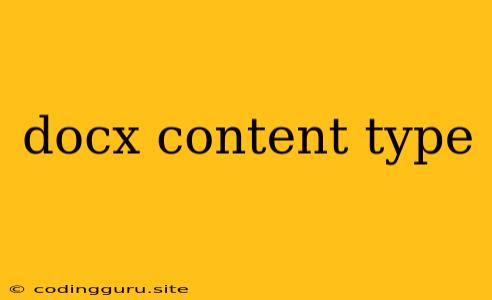What is a .docx Content Type?
The .docx file extension is a common file format used for documents created with Microsoft Word. It's a zipped archive that contains various elements of the document, including text, images, tables, formatting, and other metadata. Understanding the content type of a .docx file is crucial for various tasks, such as:
- Opening and Editing Documents: Many applications, like OpenOffice, LibreOffice, and Google Docs, can handle .docx files, allowing you to open, edit, and save them without encountering compatibility issues.
- Analyzing Document Content: Programmers and data scientists can use libraries and tools to extract specific data points from .docx files for analysis and processing.
- Building Web Applications: Developers can integrate .docx file handling into web applications, allowing users to upload, view, and manage their documents.
What are the Components of a .docx File?
The .docx file format is based on the Open Packaging Conventions (OPC) standard, which utilizes a zipped archive to store all the components of a document. The structure of a .docx file is as follows:
- [Content_Types].xml: This file defines the content types associated with each file within the archive. It's crucial for applications to correctly interpret the content and display it appropriately.
- word/document.xml: This file contains the main textual content of the document, including paragraphs, formatting, and other textual elements.
- word/styles.xml: This file defines the styles applied to the text and other elements within the document.
- word/numbering.xml: This file contains information about lists, including numbering and bullet points.
- word/settings.xml: This file stores document-level settings, such as margins, paper size, and other preferences.
- word/_rels/document.xml.rels: This file defines relationships between the main document and other files within the archive, like images and other objects.
How can I Access the Content of a .docx File?
You can access the content of a .docx file using various methods, depending on your programming language and the type of information you need.
1. Using Zip Libraries:
Many programming languages have built-in or external libraries for handling zip archives. You can use these libraries to extract the contents of the .docx file and access the individual XML files.
2. Using Document Processing Libraries:
Specialized libraries, such as Apache POI for Java, Python-docx for Python, and Docx for Ruby, offer a more convenient way to work with .docx files. These libraries allow you to read and manipulate the document's content without needing to directly access the XML files.
3. Using Open Source Tools:
Several open-source tools like unzip (Unix-based systems) or 7-Zip (Windows) can be used to extract the contents of a .docx file and access individual files.
Why is Understanding the Content Type Important?
Knowing the content type of a .docx file is crucial for several reasons:
- Compatibility: Understanding the structure and content of a .docx file allows you to develop software that can seamlessly open, edit, and save documents in this format.
- Security: By knowing the content type, you can implement appropriate security measures to prevent malicious content from being injected into the document.
- Data Analysis: Being able to extract data from .docx files allows for a deeper analysis of document content, leading to valuable insights.
Tips for Working with .docx Files
- Always Use a Reputable Library: Choose libraries from reliable sources, like official package repositories or well-maintained open-source projects, to ensure compatibility and security.
- Thoroughly Read the Documentation: Familiarize yourself with the features and limitations of the library you choose to work with. This will help you avoid common pitfalls and use the library efficiently.
- Test Your Code: Always test your code with various .docx files to ensure it handles different content types and document structures correctly.
- Consider Using a Document Processing Library: While manually extracting data from XML files is possible, using a document processing library simplifies the process and provides a more robust solution.
Conclusion
The .docx file format is widely used for document creation and sharing. Understanding its structure and content types is essential for developing software that interacts with these documents. By utilizing appropriate libraries and tools, you can seamlessly handle .docx files and leverage their data for various purposes, from document editing to data analysis.
